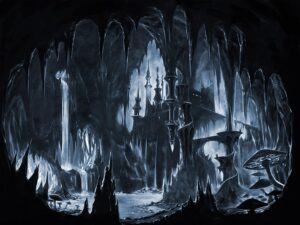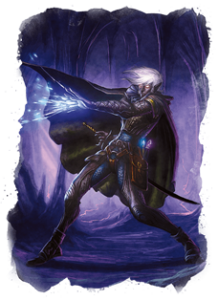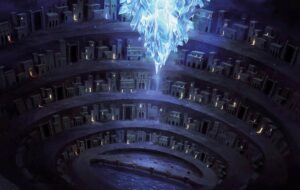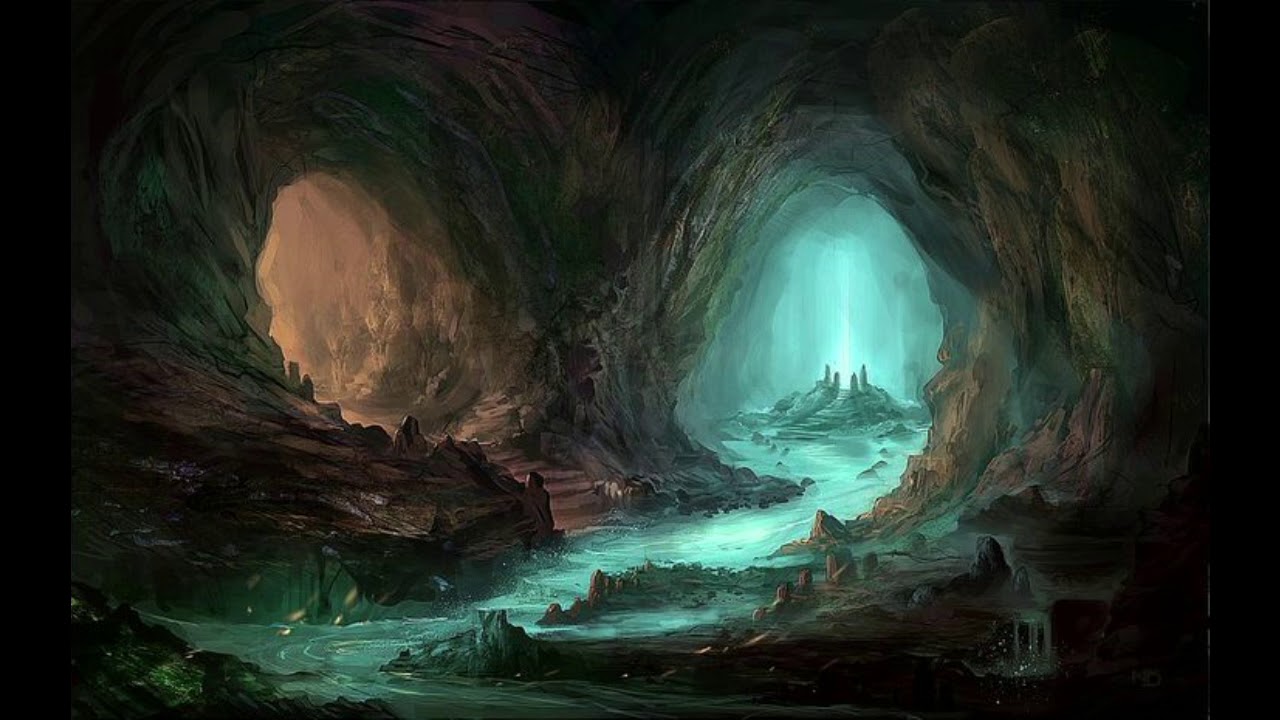Deep beneath the surface of Adnati lies the realms of the Underdark: hidden, underground passageways and civilizations that never see the light of day.
The Underdark consists of a combination of natural and hominid-created space: natural caves carved through erosion, the movement of the earth, volcanic activity, and other natural causes; tunnels and caverns carved by dwarves, goblins, and other intelligent hominids, or in the wake of creatures like the umber hulk; and in some cases, vast networks of subterranean tunnels and dwellings left behind by the Ancient Ones millennia ago during the Third Age of Men.
 Though it is commonly claimed that someone with the right training and skills could circumnavigate Adnati through the Underdark without ever needing to use the surface, most sages and scholars doubt this belief. Much of the Underdark consists of constrained, disconnected pockets of underground realms, which can vary from less than a square mile for the smallest areas to thousands of square miles for larger pockets. Some of these realms may be connected by underground passageways that can serve as roads between realms, but many are completely isolated from the rest of the Underdark.
Though it is commonly claimed that someone with the right training and skills could circumnavigate Adnati through the Underdark without ever needing to use the surface, most sages and scholars doubt this belief. Much of the Underdark consists of constrained, disconnected pockets of underground realms, which can vary from less than a square mile for the smallest areas to thousands of square miles for larger pockets. Some of these realms may be connected by underground passageways that can serve as roads between realms, but many are completely isolated from the rest of the Underdark.
Though rare, some areas of the Underdark operate as a Supernatural Region where the laws of nature and magic may operate differently. Unusual effects may also occur in the vicinity of the home of legendary creatures like an Aboleth or Elder Brain who’ve established a lair in the Underdark.
Size of the Underdark
It should be noted that smaller caves and caverns near the surface are generally not considered to be part of the Underdark, and “underground” should not be conflated with the Underdark, though some of these caves may connect to the Underdark’s vast underground network. The dungeons beneath castles and the crypts beneath temples are not part of the Underdark unless they connect to deeper realms, though an Underdark city could have its own dungeons and crypts.
Scholars debate about the size and depth of the Underdark, but most believe that networks of populated tunnels and caverns can extend miles underground in some portions. There are areas of the Underdark so vast that a visitor could spend a lifetime wandering without ever retracing their steps.
Most of the maps of the Underdark, at least among those who live on the surface, are limited fragments. If more complete maps exist, they remain cloistered in the hidden civilizations of the Drow, the Svirfneblin, the Goblins, and other subterranean peoples.
Layers of the Underdark
Sages and scholars subdivide the Underdark into three distinct layers: the Upperdark, the Middledark, and the Lowerdark.
Upperdark
The Upperdark refers to the portion of the Underdark closest to the surface. It extends approximately three miles underground, and it is in this area that surface dwellers and those who live in the Underdark most commonly meet. Underdark civilizations that do not have sunlight sensitivity, like Bugbears and Goblins, are more likely to make their homes in this part of the Underdark.
Middledark
The Middledark refers to a region of the Underdark that begins about three miles below the surface and extends to about ten miles below the surface. Intelligent hominids with sunlight sensitivity like the Drow and Duergars may have outposts and even small settlements in the Upperdark, but most of their towns and cities will be in the Middledark.
Lowerdark
The Lowerdark realms of the Underdark begin about ten miles beneath the surface and extend to unknown depths. It’s home to such fearsome monstrosities that even residents of the Middledark rarely travel that deep. Some scholars believe that there may be portals to the Abyss, the Nine Hells, Hades, and other realms of the Lower Outer Planes located in the Lowerdark. This, however, is disputed by some sages who argue that armies of devils and demons would have marched through them to conquer Adnati if they existed.
Light
The realms of the Underdark are deep beneath Adnati’s surface, where natural light from the Sun, the moons, and the stars have never reached.
Native to Darkness
 As a reaction to the Underdark’s perpetual darkness, creatures native to the Underdark typically develop one or more other senses to help them survive in the dark caverns:
As a reaction to the Underdark’s perpetual darkness, creatures native to the Underdark typically develop one or more other senses to help them survive in the dark caverns:
- Blindsight: The creature has the ability to perceive their surroundings (at least in a limited fashion) through echolocation or the psychic sense of others nearby.
- Darkvision: The most common visual sense of creatures native to the Underdark, ability to see in the dark, though only in shades of gray.
- Tremorsense: The ability to detect vibrations so precisely that they can pinpoint the locations of other creatures when they move.
- Truesight: The most powerful of the extrasensory senses, the ability to see in full color even in magical darkness, and to see invisible and ethereal creatures.
Many creatures of the Underdark can easily traverse between the surface and subterranean realms. Some, however, have become so used to their dark homes that bright sunlight can impair and even harm them. Some, like the Drow and Troglodytes, have sunlight sensitivity that cause disadvantages in combat. Others, typically undead like Vampires and Bodaks, have sunlight hypersensitivity and can take radiant damage in direct sunlight.
Even though intelligent creatures of the Underdark have their own ability to see in the dark, many civilized creatures nevertheless use other forms of illumination in their homes and towns, if only to enjoy the full range of colors beyond shades of gray.
Natural Sources of Light
 In some areas of the Underdark, phosphorescent mushrooms and phosphorescent lichens provide enough illumination for light as bright as a torch or even a lantern. Of course, it would be foolish for visitors to assume that these fungi would continue to flourish in uncharted areas, so adventurers without darkvision are advised to bring artificial or magical sources of light in their subterranean travels. Subterranean hominids are known to cultivate phosphorescent fungi in public areas where the ability to see colors is appreciated, such as areas with civic art, or fighting pits and gladiator arenas.
In some areas of the Underdark, phosphorescent mushrooms and phosphorescent lichens provide enough illumination for light as bright as a torch or even a lantern. Of course, it would be foolish for visitors to assume that these fungi would continue to flourish in uncharted areas, so adventurers without darkvision are advised to bring artificial or magical sources of light in their subterranean travels. Subterranean hominids are known to cultivate phosphorescent fungi in public areas where the ability to see colors is appreciated, such as areas with civic art, or fighting pits and gladiator arenas.
The Underdark is also home to rare gemstones called Luminescent Crystals that naturally radiate light. Each one has the brightness of a candle, but their illumination magnifies when they are brought together in clusters. Dwarves and gnomes often trade these crystals with wealthy surface-dwellers who use them in chandeliers and wall sconces to magically light their castles at night.
Dwarven Railroad
Though carved into mountainsides, dwarven fortresses and kingdoms are generally close enough to the surface that they are rarely considered to be part of the Underdark. Some dwarven mines, however, can cut deep into the Upperdark, though rarely into the Middledark unless they accidentally puncture into a pre-existing excavation.
 Within their kingdoms, dwarves have created their own subterranean railroad. In addition to smaller tracks used with pushcarts in the mines, dwarves have also created tracks within their kingdoms on which larger handcars run.
Within their kingdoms, dwarves have created their own subterranean railroad. In addition to smaller tracks used with pushcarts in the mines, dwarves have also created tracks within their kingdoms on which larger handcars run.
Smaller cars can be operated by a single driver who pumps a lever up and down. These cars can accommodate a driver, one passenger, and a small amount of baggage. Larger handcars are equipped with a beam on a pivot that two operators stand on opposite sides of to see-saw back and forth in order to move the wheels. These handcars can accommodate the two operators plus up to six passengers and the gear they carry. Steeds the size of a horse take up the room of two passengers.
Although these tracks primarily run within a single dwarven kingdom, some dwarves have constructed railroads to travel between multiple dwarven kingdoms without exiting to the surface. These tracks primarily run through the Upperdark. Longer routes that aren’t guarded properly are often targeted by bandits and Underdark marauders seeking to rob passengers – or eat them.
Underdark Inhabitants
The Underdark is a native home to numerous creatures, from unintelligent but powerful beasts and monstrosities of the night to intelligent hominids who shun the light of day.
Beastly Creatures of the Underdark
Much of the Underdark consists of naturally created caverns and roughly hewn tunnels, and these have become home to many monstrous creatures.
 These include beasts that prefer the underground, like giant rats and stirges. It also includes lesser-intelligent aberrations like otyughs and chokers, as well as more intelligent aberrations like grells and beholders. Semi-sentient oozes also make their home in the Underdark, like black puddings, gelatinous cubes, and ochre jellies.
These include beasts that prefer the underground, like giant rats and stirges. It also includes lesser-intelligent aberrations like otyughs and chokers, as well as more intelligent aberrations like grells and beholders. Semi-sentient oozes also make their home in the Underdark, like black puddings, gelatinous cubes, and ochre jellies.
And great monstrosities can also be found in the Underdark, like mimics, umber hulks, piercers, and the quite terrifying purple worms.
Most unintelligent creatures will avoid the more heavily trafficked areas of the Underdark, like hominid towns and cities. Some may make their homes in the outskirts of these areas, hoping to prey on the unsuspecting goblin or drow who ventures too far alone. Or they may make their homes near cave entrances, where they can make midnight attacks on villages on the surface.
But in some cases, more intelligent populations might entice lesser intelligent creatures into service, such as luring oozes into areas where they can act as defense in passageways or to digest refuse in pits.
Cities and Civilizations of the Underdark
 Intelligent hominids have built entire villages, cities, and even civilizations far beneath the surface of Adnati. While dwarves and gnomes who are comfortable in daylight tend to build their homes closer to the surface in the Upperdark, other creatures less tolerant of sunlight – like the Duergar, the Drow, and Kobolds – create their homes miles beneath the surface in the Middledark.
Intelligent hominids have built entire villages, cities, and even civilizations far beneath the surface of Adnati. While dwarves and gnomes who are comfortable in daylight tend to build their homes closer to the surface in the Upperdark, other creatures less tolerant of sunlight – like the Duergar, the Drow, and Kobolds – create their homes miles beneath the surface in the Middledark.
Less intelligent hominids like kobolds might make their homes in a network of natural caves and caverns, with private homes consisting of little more than alcoves off of common areas. More intelligent creatures like the drow have vast cities where families have entire private apartments carved out along tunnels that connect to common areas: marketplaces, libraries, temples, and other places that villages on the surface might have.
Some of the residents of the deepest areas of the Underdark, like the fearsome mind flayers, or illithids, have been driven there upon the collapse of their empires, where they plot their return to the surface world.
Travel in the Underdark
Travelers from the surface world to the Underdark should plan their trip carefully. Torches, lanterns, or magical light sources are almost certainly a necessity for those who lack darkvision.
 Though natives to the Underdark can tolerate the water from stagnate pools and can survive on the fungi that grow underground (at least as a supplement when meat is lacking), much of that may prove to be poisonous to visitors untrained in assessing what is safe to eat or drink. Adventures must generally bring their own food and water if they are not traveling with druids or rangers who have specialized training of the ways of the Underdark.
Though natives to the Underdark can tolerate the water from stagnate pools and can survive on the fungi that grow underground (at least as a supplement when meat is lacking), much of that may prove to be poisonous to visitors untrained in assessing what is safe to eat or drink. Adventures must generally bring their own food and water if they are not traveling with druids or rangers who have specialized training of the ways of the Underdark.
In general, adventurers will find their skills and abilities operate the same as on the surface world except when noted. Some spells like commune with nature have a different range when cast underground, while others like call lightning that do not work when the caster is indoors also won’t work when underground. Most will operate in the Underdark normally unless the spell description notes otherwise.

